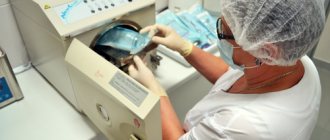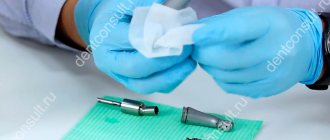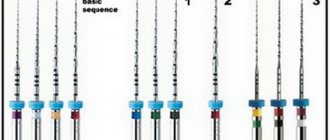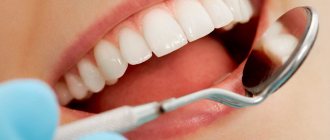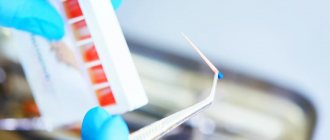Modern hand instruments, when used correctly, provide excellent results for both the doctor and the patient. It should be noted that some of these results can only be achieved using hand tools, not rotary power tools. The shape of the preparation dictates the specific circumstances in which hand instruments must be used, while the accessibility of the preparation may require different conditions.
Hand-held cutting tools are made from two main materials, carbon steel or stainless steel.
In addition, some of them have carbide inserts that add hardness to the cutting edges. Carbon steel is harder than stainless steel, but is susceptible to corrosion if not protected. Stainless steel retains its shine in most cases, but loses its edge sharpness much more quickly than carbon steel. The latter, despite its hardness and wear resistance, is brittle and cannot be used in all tools.
Other alloys containing nickel, cobalt or chromium are also used, but dental preparation instruments are not typically made from such alloys.
Types and purposes of dental instruments
The work of a dentist uses both a universal set of medical devices and specialized instruments necessary to perform highly targeted manipulations. There is a generally accepted classification of dental instruments:
- for examination of the oral cavity;
- for treatment and filling of teeth;
- for the preparation of filling and other compositions;
- for removing teeth and their roots;
- for removing dental plaque;
- for processing fillings and root canals.
The listed devices are universal and necessary for general dental procedures. In addition to them, dentistry uses ordinary and surgical instruments intended for highly specialized dentists: orthodontists, orthopedists, periodontists, hygienists, and technicians.
Dental instruments for oral examination
Diagnostic devices are included in the basic kit that every dentist needs. Their main purpose is to examine the patient’s oral cavity to identify problems and find further ways to solve them. In addition, they are necessary in the process of treatment and removal of teeth, during prosthetics.
Every dentist should have in his arsenal:
| Tool name | Photo |
| A tray in which utensils are placed. | |
| A dental mirror that magnifies the problem area and is necessary for tapping the tooth surface to assess the degree of pain. | |
| Dental tweezers, the working part of which has a curved shape and allows manipulation in hard-to-reach places. Also, using this device, the stability of the diseased tooth is checked. | |
| A dental probe that performs a number of functions: identifying irregularities and other defects on the surface of teeth, assessing their condition (density, depth, size, degree of pain). | |
| A dental spatula used to move the cheeks, tongue, and lips to the side to provide access to the damaged area. |
Set of instruments for examining the oral cavity
Instruments for examining the oral cavity - a basic dental set - consists of a tray for instruments, a magnifying mirror, tweezers with a curved handle, with which the dentist performs all the necessary manipulations in the most inaccessible places, a metal probe with a straight and curved (angled) sharpened blade, thanks to in which the doctor accurately recognizes caries and determines the depth of the fissures.
A set of tools for examining the oral cavity also helps the doctor accurately determine the painful condition of the teeth, their mobility and other deviations in the functionality of the teeth, that is, it is the No. 1 assistant for carrying out the initial diagnosis of a wide variety of diseases of the dental system.
Dental instruments for dental treatment
Tools for dental treatment are varied. They differ in names, functional purposes, and the material from which they are made. The choice of the right tools depends on what problem the patient came to the doctor with. The same instruments can be used by a dentist to treat a wide range of diseases.
In addition to the basic set of instruments used in the treatment of diseased teeth, dentistry uses a number of additional devices for carrying out highly targeted actions, for example, prosthetics.
Dental instruments for prosthetics
Prosthetics of any complexity requires an individual approach and takes a lot of time. Each stage of the procedure uses its own set of instruments.
| Name | Photo |
Impression (impression) trays designed for taking impressions from the jaw. They are classified into several main types that are used for taking impressions:
If it is necessary to make an impression of the entire dentition, large spoons are used. For impressions of individual dental units - small. Sometimes, along with standard spoons made in production, the medical technician uses special ones, selected individually. | |
| Burs and discs used for tissue preparation. | |
| Spatulas for stirring solutions. | |
| Devices used for removing, cutting, filing installed crowns. | |
| A micrometer that determines the thickness of the crown. |
Dental instruments for filling teeth
The filling procedure using cement or amalgam requires the use of special instruments, with the help of which:
- The tooth cavity in which the filling will be placed is prepared.
- The future tooth is modeled.
In modern dental practice, the following instruments are used for filling teeth:
| Name | Photo |
| A spatula is a small device in the form of a short flat spatula with a handle. Designed for introducing medication into the dental cavity, forming temporary and permanent fillings, eliminating excess material from which the filling is made. | |
| A spatula is a metal handle with flat elongated blades on both sides. Used in the preparation of pastes for filling canals and medications. | |
| A plugger is a device whose working part is a round, cylindrical or pear-shaped head. It is used to seal the filling in the dental cavity. | |
| An excavator is one of the most common devices in dentistry. It is a handle with sharp spoons along the edges facing in different directions. The main purpose is to remove excess filling material, soft plaque, temporary filling, and tartar. | |
| Handpieces for drills. They secure dental burs and abrasive materials and transmit rotation from the drill. |
During the filling process, not only the main, but also auxiliary devices can be used: matrix holders, channel fillers, strips.
Dental treatment tools
Dental instruments come in several types.
For example, hand tools are represented by plugpers and smoothers, which are used to remove softened dental tissues and fill fillings.
Manual and mechanical instruments designed for working in root canals include reamers, files, root needles, dispensers, stoppers, etc. types of dental instruments.
A separate type of dental instruments are represented by burs, diamond and polishing heads, and discs - tools for drills that work in tandem with those used with handpieces.
An important role is played by auxiliary tools, such as: clamps, punches for the matrix rubber dam, strips (abrasive strips for finishing fillings), brushes for applying liquid to the teeth.
Dental surgeon tools for teeth removal
Tooth extraction is one of the most common procedures faced by patients in dental clinics. The tools of a dental surgeon are extremely diverse. The main ones among them are elevators and tongs.
| Name and description | Photo |
| An elevator is a tool for removing teeth and their roots. There are three varieties: straight, angular, bayonet-shaped. Direct elevators are effective in removing roots in the upper jaw. Angular (lateral) ones are used to extract roots removed from the lower jaw. Elevators in the form of a bayonet are necessary for pulling out dental units in the lower jaw. | |
| Dental forceps that perform various functions. To remove teeth from the upper and lower jaws, permanent or temporary, the doctor uses different types of forceps. The most commonly used are wire cutters. | |
| A curette is a medical device shaped like a spoon with sharp edges. It is used in surgery to remove damaged tissue and suppuration from the bone. | |
| A surgical scalpel used to cut soft tissue. | |
| Surgical scissors for various manipulations related to the application or removal of sutures during surgical interventions. | |
| A syringe for administering an anesthetic drug. |
In addition to all of the above, when removing incisors, canines and molars, you may need tools for separating the gums from the jaw, tweezers for transferring and holding dressing material, needles of various thicknesses and lengths, clamps and forceps for holding a surgical needle.
Selection of instruments for preparation of dental fissures during invasive sealing
Despite the constant development and introduction of new instruments and restoration materials into dental practice, improvement of methods and technologies for their use, many unresolved problems remain in practical therapeutic dentistry. One of them is the effective prevention and treatment of the initial stages of caries of chewing teeth by the method of invasive sealing of fissures with flowable composites.
A promising direction in this area is the use of special burs for therapeutic and prophylactic fissurotomy, which are created taking into account the shape of the fissure for minimal excision of tooth tissue. The most famous in our country are carbide fissurotomy burs. However, given the shape of the cavity resulting from preparation with such burs, the quality of its filling with filling material is questionable, even when using flowable composites.
In this regard, the purpose of our study was a comparative assessment of the quality of filling cavities in the fissure area of chewing teeth with a flowable composite, depending on the configuration of the working part of the bur used for fissurotomy. We conducted a comparative study of carbide burs with a pointed tip of the working part and cone-shaped diamond burs with a rounded tip of the working part with a diameter of 1.2 mm (Fig. 1).
Rice. 1. Fissurotomy burs of various designs: a - carbide fissurotomy bur; b - cone-shaped diamond bur with a rounded top.
Each type of bur was used to prepare the fissures of 25 premolars removed for medical reasons (Fig. 2a).
Rice. 2. The main stages of the study: a - preparation of fissures of removed premolars; b — filling the cavity with a flowable composite; c — making sections of teeth.
After preparation, adhesive preparation of the cavities was carried out using the total etching technique (Table No. 1).
Table No. 1. List of tools and materials used during the study
| Stage | Group teeth No. 1 | Group teeth No. 2 |
| Fissurotomy | Carbide bur with a pointed tip of the working part | D.845.012.FG (Frank Dental) |
| Adhesive preparation | UltraEtch etching gel (Ultradent); adhesive Gluma 2bond (Heraeus) | |
| Composite material | Charisma Opal flow (Heraeus) | |
| Curing lamp | VALO (Ultradent) | |
All cavities were then filled with light-curing flowable composite (Figure 2b).
Filling was performed with one portion of material. The distribution of the composite in the cavity was carried out with a sharp dental probe. For photopolymerization of the material, a high-power activating lamp with a broadband emission spectrum was used. After this, we made longitudinal sections of all filled teeth, passing through the bottom of the cavity (Fig. 2c).
The marginal adherence of the material to the walls and bottom of the cavity was assessed visually with an optical magnification of 3.5 times, tactilely using a dental probe and by staining sections with a caries detector (Fig. 3).
Rice. 3. Assessment of marginal fit: a - visually; b — probing the filling/tooth boundary; c — staining of thin sections with a caries detector.
In the course of analyzing the results of the study, we found that when performing fissurotomy using cone-shaped diamond burs, high-quality, uniform filling of the cavity with composite material was obtained in 96% of cases (Fig. 4).
Rice. 4. Results of analysis of the quality of filling cavities with flowable composite in the studied groups of teeth: a, b - complete, uniform filling of the cavity with flowable composite; c, d - defects in filling the cavity with a flowable composite.
When using carbide burs with a pointed tip of the working part, high-quality filling of the cavity with composite material was recorded only in 44% of cases. In 56% of observations, filling defects were noted in the area of the cavity bottom and a violation of the marginal fit of the composite.
We explain such a high frequency of violation of the marginal seal by the discrepancy between the shape of the cavity when performing fissurotomy with peak-shaped burs with a pointed tip and the fluidity of the filling material. Based on the data obtained, we recommend using cone-shaped burs with a rounded tip of the working part with a diameter of at least 1.2 mm for carrying out therapeutic and prophylactic fissurotomy using flowable composites as a filling material (Fig. 5, 6).
Rice. 5. Cone-shaped diamond bur with a rounded tip of the working part with a diameter of 1.2 mm (D.845.012.FG, Frank Dental).
Rice. 6. Performing fissurotomy with a cone-shaped diamond bur with a rounded tip of the working part.
Tools for removing plaque from teeth
Very often, patients turn to the dentist who want to get rid of deposits on the surface of their teeth and gums. For these purposes, tools are produced under the following names:
- Curettes. Instruments that have different shapes, which facilitates their penetration into any part of the oral cavity.
- Hooks of different shapes and sizes. Used to clean the tooth surface and gums from deposits.
- Excavators. Necessary for removing temporary fillings, pieces of food, as well as deposits that form above or below the gum, in the periodontal canals.
- Attachments for pneumatic or ultrasonic scalers. Effective in removing deposits above the gums, as well as in cleaning the area between the teeth. A device such as a scaler should not be used in the presence of subgingival deposits.
- Enamel knife. Used for polishing and giving the ideal color to tooth enamel.
- Root file. A dental instrument used in the final stage of a dental plaque removal procedure. It is used to grind the surface of the root.
It is not so easy to list all the main dental instruments used in modern medical practice. The number of devices that every specialist should have in their arsenal is steadily increasing, as treatment methods are constantly being improved, new approaches to practical activities are being developed, and the quality of services provided is growing. It is important to correctly navigate and understand the variety of existing tools, using new technologies and developments.
Where is it profitable to buy dental instruments?
You can always buy high-quality dental instruments profitably in Moscow in the Dental Market online store.
Call Dental Market by phone 8
, check the availability of the product you are interested in and receive discounts! Our manager-consultants will be happy to answer any questions you may have, help you choose the dental instruments you need, and will always tell you what types of dental instruments the company is currently running a promotion on.
“Dental Market” is an online store for those who value their work and the health of their patients.
